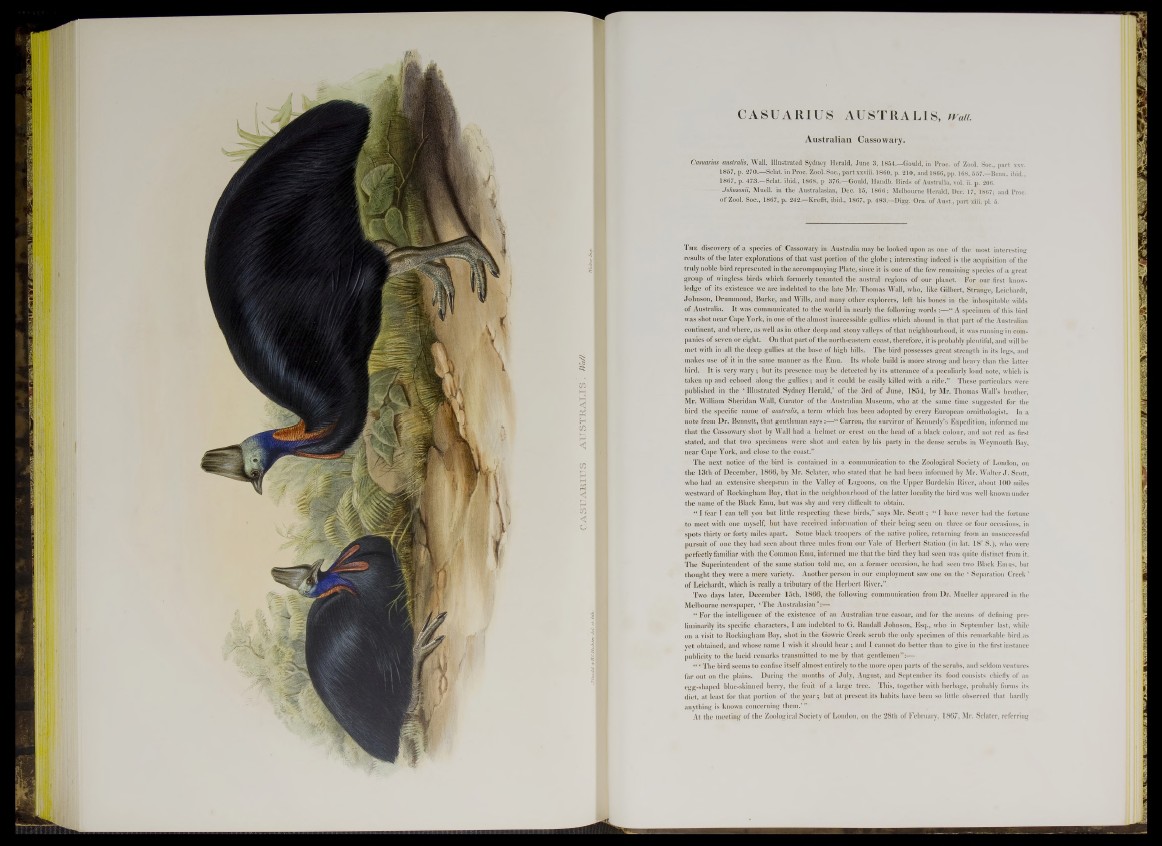
CASUAIKIITS AIJSTKALIS . W all/
CASUARIUS AUSTRALIS, Wail.
Australian Cassowary.
Casuarius australis, Wall, Illustrated Sydney Herald, June 3, 1854.—Gould, in Proc. of Zool. Soc., part xxv.
1857, p. 270.—Sclat. in Proc. Zool. Soc., partxxviii. 1860, p. 210, and 1866, pp. 168, 557.—Benn. ibid.,
1867, p. 473.—Sclat. ibid., 1868, p 376.—Gould, Handb. Birds of Australia, vol. ii. p. 206.
---- Johnsonii, Muell. in the Australasian, Dec. 15, 1866; Melbourne Herald, Dec. 17, 1867; and Proc.
of Zool. Soc., 1867, p. 242.—Krefft, ibid., 1867, p. 483.-^Digg. Orn. of Aust., part xiii. pi. 5.
T he discovery of a species of Cassowary in Australia may be looked upon as one of the most interesting
results of the later explorations of that vast portion of the globe; interesting indeed is the acquisition of the
truly noble bird represented in the accompanying Plate, since it is one of the few remaining species of a great
group of wiugless birds which formerly tenanted the austral regions of our planet. For our first knowledge
of its existence we are indebted to the late Mr. Thomas Wall, who, like Gilbert, Strange, Leichardt,
Johnson, Drummond, Burke, and Wills, and many other explorers, left his bones in the inhospitable wilds
of Australia. It was communicated to the world in nearly the following words :—“ A specimen of this bird
was shot near Cape York, in one of the almost inaccessible gullies which abound in that part of the Australian
continent, and where, as well as in other deep and stony valleys of that neighbourhood, it was runnino-in companies
of seven or eight. On that part of the north-eastern coast, therefore, it is probably plentiful, and will be
met with in all the deep gullies at the base of high hills. The bird possesses great strength in its legs, and
makes use of it in the same manner as the Emu. Its whole build is more strong and heavy than the latter
bird. It is very wary; but its presence may be detected by its utterance of a peculiarly loud note, which is
taken up and echoed along the gullies ; and it could be easily killed with a rifle.” These particulars were
published in the ‘ Illustrated Sydney Herald/ of the 3rd of June, 1854, by Mr. Thomas Wall’s brother,
Mr. William Sheridan Wall, Curator of the Australian Museum, who at the same time suggested for the
bird the specific name of australis, a term which has been adopted by every European ornithologist. In a
note from Dr. Bennett, that gentleman says H si‘ Carron, the survivor of Kennedy’s Expedition, informed me
that the Cassowary shot by Wall had a helmet or crest on the head of a black colour, and not red as first
stated, and that two specimens were shot and eaten by his party in the dense scrubs in Weymouth Bay,
near Cape York, and close to the coast.”
The next notice of the bird is contained in a communication to the Zoological Society of London, on
the 13th of December, 1866, by Mr. Sclater, who stated that he had been informed by Mr. Walter J . Scott,
who had an extensive sheep-run in the Valley of Lagoons, on the Upper Burdekin River, about 100 miles
westward of Rockingham Bay, that in the neighbourhood of the latter locality the bird was well known under
the name of the Black Emu, but was shy and very difficult to obtain.
“ I fear I can tell you but little respecting these birds,” says Mr. S co tt; “ I have never had the fortune
to meet with one myself, but have received information of their being seen on three or four occasions, in
spots thirty or forty miles apart. Some black troopers of the native police, returning from an unsuccessful
pursuit of one they had seen about three mdes from our Vale of Herbert Station (in lat. 18° S.), who were
perfectly familiar with the Common Emu, informed me that the bird they had seen was quite distinct from it.
The Superintendent of the same station told me, on a former occasion, he had seen two Black Emus, but
thought they were a mere variety. Another person in our employment saw one on the ‘ Separation Creek ’
of Leichardt, which is really a tributary of the Herbert River.”
Two days later, December 15th, 1866, the following communication from Dr. Mueller appeared in the
Melbourne newspaper, ‘The Australasian’:—
“ For the intelligence of the existence of an Australian true casoar, and for the means of defining preliminarily
its specific characters, I am indebted to G. Randall Johnson, Esq., who in September last, while
on a visit to Rockingham Bay, shot in the Gowrie Creek scrub the only specimen of this remarkable bird,.as
yet obtained, and whose name I wish it should b e a r; and I cannot do better than to give in the first instance
publicity to the lucid remarks transmitted to me by that gentlemen” :—
“ ‘ The bird seems to confine itself almost entirely to the more open parts of the scrubs, and seldom ventures
far out on the plains. During the months of July, August, and September its food consists chiefly of an
egg-shaped blue-skinned berry, the fruit of ,a large tree. This, together with herbage, probably forms its
diet, at least for that portion of the year; but at present its habits have been so little observed that hardly
anything is known concerning them.’ ”
At the meeting of the Zoological Society of London, on the 28th of February, 1867, Mr. Sclater, referring